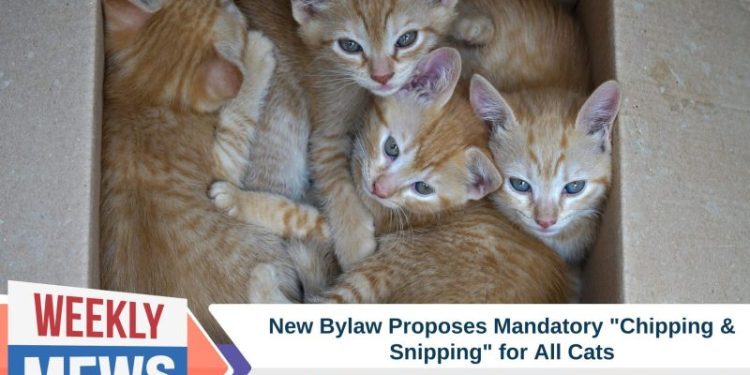
The Far North District of New Zealand (situated in, you guessed it, the far north of the country) is set to debate a significant change in animal regulations, with a proposed bylaw that would require all cats over the age of four months to be both microchipped and desexed.
The new rules, if adopted, would be the first animal regulations in the district since 2019, when the previous bylaw lapsed. As a result, pet management has become an increasing challenge, especially for cats, which are not covered by any current regulations. While the bylaw would regulate desexing, there would be no limit on the number of cats per household. The bylaw also proposes restrictions on other animals, including bans on roosters and pigs in urban areas.
New Zealand has been in the international news for its view on feral cats in the past when the announcement of a feral cat-hunting contest for kids went viral. The public anger led organizers to withdraw the event, though they maintained that the junior hunting tournament to kill feral cats was about “protecting native birds and other vulnerable species.”
So, where do feral cats fit in societies, especially in Island nations like New Zealand or Australia, where the expanding populations are threatening and endangering native animal species?
While house cats are popular and beloved in New Zealand, a country with only 5.2 million people, there are an estimated 2.4 million feral cats. Thus, seeing new bylaws proposed that are ‘fences at the top’ instead of ‘ambulances at the bottom’, like hunting competitions, could hopefully be the way of the future and give the cats and the public a chance to align.
The issue of feral cats has been a tense topic for many years between animal lovers and authorities globally, due to the impact they have on other wildlife. In New Zealand, one such species threatened by feral cats (but not limited to) is the kiwi, the country’s currently endangered national bird. Kiwi birds have an estimated population of 68,000, which is decreasing by 2% each year – roughly 20 kiwis per week.
A Gap in Pet Management
The lapse of the previous bylaw in 2019 left a regulatory gap, meaning the district has had no formal control over pet populations other than dogs, which are regulated under a separate bylaw. The absence of rules has made it difficult for the Far North District Council to respond effectively to residents’ complaints about nuisance or stray animals, and animal welfare organizations have been stretched incredibly thin trying to manage issues caused by the uncontrolled breeding of stray cats.
Under the proposed new bylaw, the council would gain tools to manage not only the behavior of pet owners but also the environmental and community impacts of unregulated animal populations.
Key Provisions for Cats
The proposed “chipping and snipping” requirement for cats over four months of age is one of the bylaw’s central features. This new rule is designed to tackle the growing population of stray and unowned cats, a pressing issue in the Far North District, which has a mild climate that enables nearly year-round breeding for cats.
Animal rescues, like Coast to Coast Cat Rescue based in Kerikeri, are flooded with kittens and stray cats. As of September 2024, Coast to Coast has taken in nearly 2,100 cats and kittens since 2021 alone. According to Sam Stewart, the founder of the organization, very few of these animals were desexed or microchipped when they arrived, and many were either strays or had been abandoned by their previous owners.
Microchipping and desexing are seen as crucial steps in both managing the cat population and ensuring the animals’ welfare. Microchipping provides a permanent form of identification, increasing the chances that lost or stray cats can be returned to their owners and reducing the number of unidentified strays ending up in rescues. Desexing helps reduce unwanted litters and inhumane treatment of them, which is especially important in regions where mild climates make for long breeding seasons.
Exceptions would be made for registered breeding cats or if a veterinarian certifies that desexing would be harmful to the cat’s health. In addition to microchipping and desexing, the bylaw leaves out a cap on the number of cats per household, under the reasoning that cat hoarding only becomes a problem if the animals are not managed responsibly.
Protecting Native Bird Populations
With animal welfare in mind, one of the most urgent reasons for this bylaw is the impact of stray and feral cats on New Zealand’s native wildlife. Cats, whether owned or feral, are natural predators of birds, and they pose a serious threat to New Zealand’s unique bird species. With some species already endangered, hunting cats add significant pressure to these fragile populations. The tūī, kākā, fantail, and aforementioned kiwi are among the vulnerable species that roam or nest in areas frequented by cats. The hunting instinct of even well-fed domestic cats can harm native bird numbers, especially in regions like the Far North, where many birds are ground-dwelling and thus more accessible to predators.
Cats have been introduced to an environment where native species evolved without land-based mammalian predators, making them especially vulnerable. For example, the kiwi bird is flightless and nocturnal, aligning their wake time with the feral cat population. One of their main adapted defenses is ‘freezing’, which isn’t fine against predatory birds who use sight to hunt, but not so helpful against cats, who use scent.
In the video below you can see the kiwi ‘freezing’. The feral cat was too busy eating to worry about the kiwi on film.
The bylaw’s focus on desexing and managing stray cats could reduce these risks, helping to create safer environments for New Zealand’s birds and supporting broader conservation efforts.
Community Impact and Moving Toward Responsible Pet Ownership
Those proposing the bylaw hope it will be a turning point and have a lasting positive impact on pet ownership behaviors in the Far North region, aiming to educate and encourage responsible pet ownership. By requiring basic steps like microchipping and desexing, the bylaw could help reduce the number of stray and unwanted animals and lead a cultural shift in how pets are managed.
The bylaw proposal excludes the need for a limit on the number of cats per household, as long as they are desexed, microchipped, and cared for responsibly (responsible care being the key phrase). Hoarding situations only become an issue when the number of animals a person keeps exceeds their ability to care for them responsibly, so those would still be addressed by the SPCA, mental health services, or council inspectors.
Consultation and Next Steps
The public has until November 18 to submit their views on the bylaw, with consultation open since September. If passed, the Far North District would join other districts in the country in enforcing compulsory microchipping and desexing to reduce cat overpopulation and its impacts.
- What are your thoughts on compulsory chipping and desexing?
- Do you believe this bylaw will help protect New Zealand’s native birds? How important is this for conservation?
We’d love to hear from you in the comment section below (beneath the feedback stars, keep scrolling down!).





